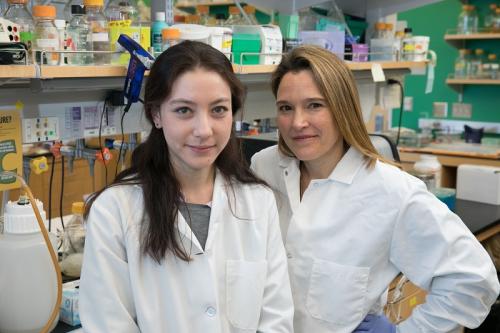
UCLA scientists study how intestinal stem cells age
As humans get older, it’s not just skin that shows the impact of age; among many other changes, the intestines—which include both the small intestine and the large intestine, often called the colon—tend to be more prone to inflammation, putting older people at a higher risk of colon cancer.
Now, researchers at the Eli and Edythe Broad Center of Regenerative Medicine and Stem Cell Research at UCLA have shown that stem cells from the intestines retain markers of their age even when they are isolated from a person’s body and grown in a lab.
“We really don’t have a lot of good models to study aging,” said Leanne Jones, a professor of molecular, cell, and developmental biology and senior author of the study, published in Cellular and Molecular Gastroenterology and Hepatology. “These findings will help us study how and why intestinal aging happens.”
The lining of both the small intestine and colon contain deep folds called crypts. Inside these crypts are intestinal stem cells, which give rise to mature intestinal cells throughout a person’s lifetime. Recently, researchers have begun isolating crypts and using the stem cells they contain to form intestinal organoids—small clusters of cells that can be used to study intestinal biology or study the effect of drugs on the intestines.
In the new work, Jones, along with graduate student Sophia Lewis, isolated stem cell-containing crypts from 38 small intestine and colon samples that had been collected during intestinal surgeries at UCLA. The cells, which came from healthy tissue in patients ranging from age 0 to 85, were used to create both small intestine and colon organoids.
Then, the researchers analyzed the DNA methylation age, also known as DNAm age, of each organoid using an established age calculation that takes advantage of methylation, chemical marks on DNA that change in predictable ways throughout the human lifespan. In previous studies, scientists have established that the DNAm age of many different tissues accurately reflects the age of the patients from which those tissues originated. However, DNAm age had not been tested in organoids made from intestinal stem cells.
The small intestine and colon organoids, Jones and Lewis discovered, had a DNAm age very close to the DNAm age of the crypts the cells came from originally, suggesting that the stem cells retain markers of their age even after being isolated from their natural environment. However, the DNAm age wasn’t always a perfect match to the patient’s age.
Cells isolated from colon crypts, the authors discovered, had an age very close to the true age of the patient that the cells came from. But cells isolated from small intestine crypts showed a different pattern: cells of young patients had an accurate DNAm age, while those isolated from patients over age 40 seemed to be aging more slowly. In some cases, the DNAm age of cells from small intestine crypts was nearly 20 years younger than the patient’s age. The results suggest that the small intestine ages more slowly than the colon beginning in middle age.
“If the small intestine is protected against aging somehow, that may explain why small intestine cancers are so rare, when compared to colon cancers,” said Lewis, the first author of the new paper.
Moving forward, the team will design further studies that can help establish a link between age and cancer risk as well as probe what qualities of the small intestine—such as bacterial content—might slow the aging of its DNA. Since the DNAm age of organoids matched the DNAm age of the crypt cells they were developed from, the researchers believe organoids will be a useful tool in aging research.
“Our study adds to the idea that organoids are a very robust model to study the basic biology of stem cells and their aging,” said Lewis.
The research was supported by a UCLA Broad Stem Cell Research Center Rose Hills Foundation Graduate Scholarship, a UCLA Broad Stem Cell Research Center Rose Hills Foundation Innovator Grant, a CURE: Digestive Diseases Research Center at UCLA Pilot and Feasibility Study Award and a David Geffen School of Medicine at UCLA Regenerative Medicine Theme Award, supported by the UCLA Clinical and Translational Science Institute and UCLA Broad Stem Cell Research Center.